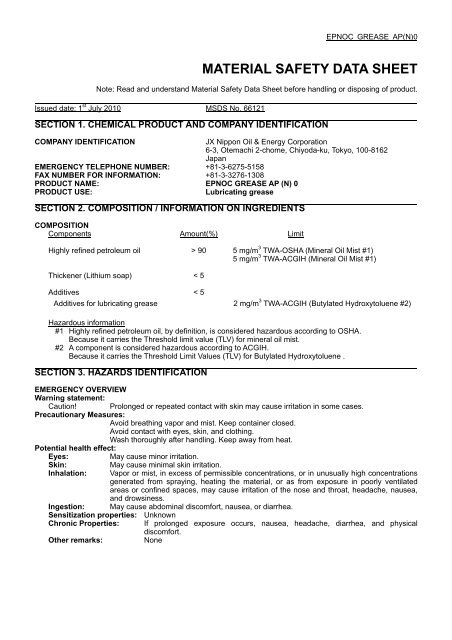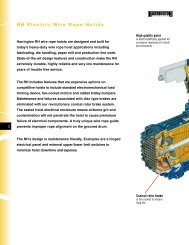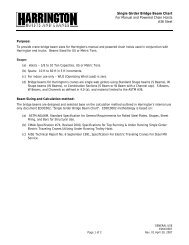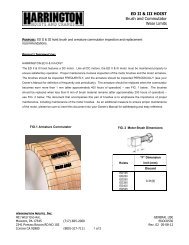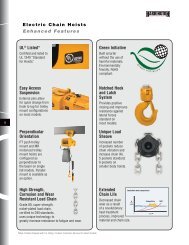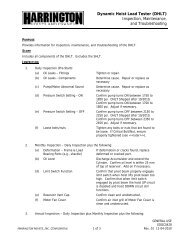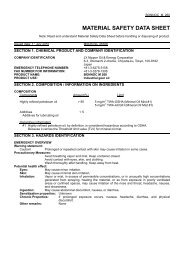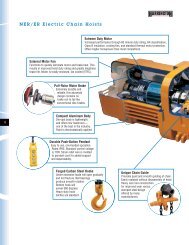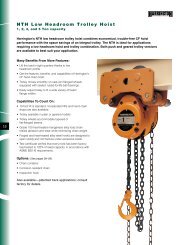(N)ER Model Load Chain Grease - Harrington Hoists and Cranes
(N)ER Model Load Chain Grease - Harrington Hoists and Cranes
(N)ER Model Load Chain Grease - Harrington Hoists and Cranes
Create successful ePaper yourself
Turn your PDF publications into a flip-book with our unique Google optimized e-Paper software.
EPNOC GREASE AP(N)0<br />
MAT<strong>ER</strong>IAL SAFETY DATA SHEET<br />
Note: Read <strong>and</strong> underst<strong>and</strong> Material Safety Data Sheet before h<strong>and</strong>ling or disposing of product.<br />
Issued date: 1 st July 2010 MSDS No. 66121<br />
SECTION 1. CHEMICAL PRODUCT AND COMPANY IDENTIFICATION<br />
COMPANY IDENTIFICATION<br />
EM<strong>ER</strong>GENCY TELEPHONE NUMB<strong>ER</strong>: +81-3-6275-5158<br />
FAX NUMB<strong>ER</strong> FOR INFORMATION: +81-3-3276-1308<br />
JX Nippon Oil & Energy Corporation<br />
6-3, Otemachi 2-chome, Chiyoda-ku, Tokyo, 100-8162<br />
Japan<br />
PRODUCT NAME: EPNOC GREASE AP (N) 0<br />
PRODUCT USE:<br />
Lubricating grease<br />
SECTION 2. COMPOSITION / INFORMATION ON INGREDIENTS<br />
COMPOSITION<br />
Components Amount(%) Limit<br />
Highly refined petroleum oil > 90 5 mg/m 3 TWA-OSHA (Mineral Oil Mist #1)<br />
5 mg/m 3 TWA-ACGIH (Mineral Oil Mist #1)<br />
Thickener (Lithium soap) < 5<br />
Additives < 5<br />
Additives for lubricating grease 2 mg/m 3 TWA-ACGIH (Butylated Hydroxytoluene #2)<br />
Hazardous information<br />
#1 Highly refined petroleum oil, by definition, is considered hazardous according to OSHA.<br />
Because it carries the Threshold limit value (TLV) for mineral oil mist.<br />
#2 A component is considered hazardous according to ACGIH.<br />
Because it carries the Threshold Limit Values (TLV) for Butylated Hydroxytoluene .<br />
SECTION 3. HAZARDS IDENTIFICATION<br />
EM<strong>ER</strong>GENCY OV<strong>ER</strong>VIEW<br />
Warning statement:<br />
Caution! Prolonged or repeated contact with skin may cause irritation in some cases.<br />
Precautionary Measures:<br />
Avoid breathing vapor <strong>and</strong> mist. Keep container closed.<br />
Avoid contact with eyes, skin, <strong>and</strong> clothing.<br />
Wash thoroughly after h<strong>and</strong>ling. Keep away from heat.<br />
Potential health effect:<br />
Eyes:<br />
May cause minor irritation.<br />
Skin:<br />
May cause minimal skin irritation.<br />
Inhalation: Vapor or mist, in excess of permissible concentrations, or in unusually high concentrations<br />
generated from spraying, heating the material, or as from exposure in poorly ventilated<br />
areas or confined spaces, may cause irritation of the nose <strong>and</strong> throat, headache, nausea,<br />
<strong>and</strong> drowsiness.<br />
Ingestion: May cause abdominal discomfort, nausea, or diarrhea.<br />
Sensitization properties: Unknown<br />
Chronic Properties: If prolonged exposure occurs, nausea, headache, diarrhea, <strong>and</strong> physical<br />
discomfort.<br />
Other remarks:<br />
None
EPNOC GREASE AP(N)0<br />
SECTION 4. FIRST AID MEASURES<br />
Eyes:<br />
Flush immediately with water for at least 15 minutes. Get immediate medical attention.<br />
Skin:<br />
Wash with soap <strong>and</strong> water. Get medical attention if irritation develops.<br />
Launder contaminated clothing before reuse.<br />
Inhalation: Remove exposed person to fresh air if adverse effects are observed.<br />
Ingestion:<br />
Do not make person vomit unless directed to do so by medical personnel.<br />
Note to physician: Treat symptomatically.<br />
SECTION 5. FIRE FIGHTING MEASURES<br />
Flash point (Typical), <br />
Autoignition tempt., <br />
Flammability limits:<br />
Extinguishing media:<br />
Special fire fighting procedures:<br />
Not Determined.<br />
Not Determined.<br />
Not Determined.<br />
CO 2 , dry chemical, or foam.<br />
Recommend wearing self-contained breathing apparatus. Water may<br />
cause splattering. Material will float on water.<br />
Unusual fire & explosion hazards: Toxic fumes, gases or vapors may evolve on burning.<br />
Explosion data:<br />
Material does not have explosive properties.<br />
SECTION 6. ACCIDENTAL RELEASE MEASURES<br />
Procedures in Case of Accidental Release, Breakage or Leakage:<br />
Stop the source of the leak or release. Clean up releases as soon as possible. Contain liquid to prevent further<br />
contamination of soil, surface water or groundwater. Clean up small spills using appropriate techniques such as<br />
sorbent materials or pumping. Where feasible <strong>and</strong> appropriate, remove contaminated soil. Follow prescribed<br />
procedures for reporting <strong>and</strong> responding to larger releases.<br />
SECTION 7. HANDLING AND STORAGE<br />
Do not weld, heat or drill container. Replace cap or bung. Emptied container still contains hazardous material<br />
which may ignite with explosive violence if heated sufficiently.<br />
Minimum feasible h<strong>and</strong>ling temperatures should be maintained.<br />
Periods of exposure to high temperatures should be minimized.<br />
Water contamination should be avoided.<br />
CAUTION: Do not use pressure to empty drum or drum may rupture with explosive force.<br />
SECTION 8. EXPOSURE CONTROLS / P<strong>ER</strong>SONAL PROTECTION<br />
Eye Protection:<br />
Chemical type goggles or face shield optional.<br />
Skin Protection: Avoid prolonged or frequently repeated skin contact by wearing impervious protective<br />
clothing including gloves.<br />
Respiratory Protection: Wear a breathing mask.<br />
Ventilation:<br />
No special ventilation is usually necessary. However, if operating conditions create<br />
high air borne concentrations of this material, special ventilation may be needed.<br />
Other clothing <strong>and</strong> Equipment:<br />
No special clothing or equipment is usually necessary.<br />
Work practices, hygienic practices: No information is available.<br />
Other h<strong>and</strong>ling <strong>and</strong> storage requirements: No information is available.<br />
Protective measures during maintenance of contaminated equipment: No Data Available.
EPNOC GREASE AP(N)0<br />
SECTION 9. PHYSICAL AND CHEMICAL PROP<strong>ER</strong>TIES<br />
Odor<br />
Slight odor<br />
Appearance<br />
Light brown buttery<br />
Boiling point No Data Available<br />
Solubility<br />
Insoluble in water<br />
Density @15, g/cm 3 No Data Available<br />
Dropping point 193<br />
Penetration worked @25, 60W 362<br />
DMSO Extract (Base oil) mass % (IP 346) < 3<br />
SECTION 10. STABILITY AND REACTIVITY<br />
Stability:<br />
Conditions to Avoid:<br />
Incompatibility (materials to avoid):<br />
Hazardous Polymerization:<br />
Thermal decomposition:<br />
SECTION 11. TOXICOLOGICAL INFORMATION<br />
Stable<br />
See the H<strong>and</strong>ling <strong>and</strong> storage section for further details.<br />
Acids. Oxidizing agents. Halogens <strong>and</strong> halogenated compounds.<br />
Will not occur<br />
Smoke, carbon monoxide, aldehydes <strong>and</strong> other products of incomplete<br />
combustion. Hydrogen sulfide <strong>and</strong> alkyl mercaptans <strong>and</strong> sulfides may<br />
also be released. Under combustion conditions, oxides of the following<br />
elements will be formed: Calcium, Sulfur, Zinc.<br />
Acute Oral: No Data Available: Believed to be greater than 5 g/kg (rat)<br />
Practically non-toxic<br />
Dermal: No Data Available: Believed to be greater than 3 g/kg (rabbit)<br />
Practically non-toxic<br />
Carcinogen: OSHA: This material is listed as Group 3 by IARC.<br />
(Base oil) EU: The classification as a carcinogen need not apply.<br />
SECTION 12. ECOLOGICAL INFORMATION<br />
Biodegradation:<br />
Environmental fate:<br />
No Data Available<br />
This material is not expected to present any environmental problems other than those<br />
associated with oil spills.<br />
SECTION 13. DISPOSAL CONSID<strong>ER</strong>ATIONS<br />
Waste Disposal Method:<br />
Place contaminated materials in disposable containers <strong>and</strong> dispose of in a manner consistent with applicable<br />
regulations. Contact local environmental or health authorities for approved disposal of this material.<br />
SECTION 14. TRANSPORT INFORMATION<br />
The description shown may not apply to all shipping situations.<br />
DOT Proper Shipping Name: Not applicable.<br />
IMDG Proper Shipping Name: Not applicable.<br />
ICAO Proper Shipping Name: Not applicable.<br />
TDG Proper Shipping Name: Not applicable.<br />
NFPA Proper name: Class 1.<br />
UN Number:<br />
Not applicable.
EPNOC GREASE AP(N)0<br />
SECTION 15. REGULATORY INFORMATION<br />
The U.S.TSCA inventory:<br />
The EC EINECS inventory:<br />
The CANADA DSL inventory:<br />
The AUSTRALIA AICS inventory:<br />
The KOREA TCCL inventory:<br />
The PHILIPPINE PICCS inventory:<br />
SECTION 16. OTH<strong>ER</strong> INFORMATION<br />
None<br />
References:<br />
All components of this material are on the US TSCA inventory.<br />
All components of this material are on the EC EINECS inventory.<br />
All components of this material are on the DSL inventory.<br />
All components of this material are on the AICS inventory.<br />
All components of this material are on the TCCL inventory.<br />
All components of this material are on the PICCS inventory.<br />
1. H<strong>and</strong>book of Toxic <strong>and</strong> Hazardous Chemicals <strong>and</strong> Carcinogens (2nd ed.)<br />
2. Registry of Toxic Effects of Chemical Substances (NIOSH, 1983)<br />
Material safety data sheets are provided as reference information on the safe h<strong>and</strong>ling of hazardous or harmful<br />
materials to companies using such materials. When referring to this data sheet, companies should remember that<br />
they must take responsibility for implementing the proper measures for their own particular situations. This data<br />
sheet is not a guarantee of safety.


